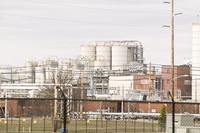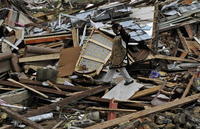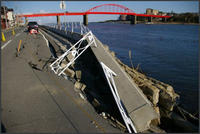-
Identifying Canadians from their date of birth, postal code
Researchers find that 97 percent of Canadians can be uniquely identified from their date of birth and postal code; this means that if these to items of information, plus gender, exist in any database, even if it has no names or other identifying information, it would be possible to determine the identity of those individuals birth
-
-
Wire pops lock certified for US defense facilities
The Access Control E-Plex 5800 lock from Swiss company Kaba was described as the first lock certified as meeting new DHS requirements for coded access that keeps track of which contractors or federal workers open which doors; at the DefCon event in Las Vegas, a security expert demonstrated how this high-security lock, certified for use in sensitive U.S. government facilities, can be easily opened with just a piece of wire
-
-
Sector Report for Monday, 8 August 2011: Infrastructure protection
This report contains the following stories.
Plus 1 additional story.
-
-
Market forces to help reduce emission, increase storage of CO2
New computer modeling work shows that by 2100, if society wants to limit carbon dioxide in the atmosphere to less than 40 percent higher than it is today, the lowest-cost option is to use every available means of reducing emissions — including using forests to store carbon
-
-
Dow fined $2.5 million for violations at Michigan chem plant

Due to environmental and safety violations at its chemical plant in Midland, Michigan, Dow Chemical will have to pay $2.5 million in fines; federal inspectors found that the chemical plant violated air, water, and waste regulations between 2005 and 2007
-
-
Improved engineering to protect structures on storm’s edge

In the wake of the horrendous tornadoes that delivered massive destruction to Alabama in April, University of Alabama engineers have analyzed building structures and design codes to recommend an approach to safer and stronger buildings going forward
-
-
Averting bridge disasters: new sensors could save hundreds of lives
One of every four U.S. highway bridges has known structural problems or exceeded its intended life-span. Most only get inspected once every one or two years; University of Maryland researcher has developed a new sensor that measures indicators of a bridge’s structural health, such as strain, vibration, flexibility, and development of metal cracks; the sensors are expected to last more than a decade, with each costing about $20
-
-
Earthquakes: scientists will shake 5-story building in Japan
Landmark earthquake engineering tests this summer in Japan could open the door for earthquake-proofing technology applied to hospitals, nuclear power plants, and emergency-response facilities to be more common in the United States, and confirm the capabilities for the technology used in Japan and the rest of the world
-
-
Bridge destruction to offer clues about 'fracture-critical' spans
A civil engineer at Purdue University is taking advantage of the demolition of a bridge spanning the Ohio River to learn more about how bridges collapse in efforts to reduce the annual cost of inspecting large spans
-
-
Sensing "skin" protects concrete structures
Scientists have developed a sensing “skin” which is made of stretchy thermoplastic elastomer mixed with titanium dioxde; patches of the skin are painted with black carbon to measure changes in the electrical charge of the skin; the skin will be rolled out in patches across structures such as bridges and dams; the formation of a crack would cause a movement in the concrete under the patch, which would change the capacitance, or stored energy, of the skin; daily check by computers would detect the change the capacitance, and issue and alert
-
-
Protecting water utilities from terrorist attacks and contaminants
In 1993, a cryptosporidiosis outbreak in Milwaukee contaminated the city’s water supplies, hastened the deaths of dozens of citizens, made more than 400,000 residents ill, and cost more than $96 million in medical expenses and lost productivity; Sandia’s CANARY software protects water utilities from terrorist attacks and contaminants
-
-
Sector Report for Monday, 25 July 2011: Infrastructure protection
This report contains the following stories.
Plus 1 additional story.
-
-
DHS warns utilities at risk from insider threats
Last week DHS warned critical infrastructure operators like chemical facilities, nuclear power plants, and electric utility companies that terrorists could be targeting major facilities from the inside; officials cautioned that “violent extremists have, in fact, obtained insider positions,” and that “outsiders have attempted to solicit utility-sector employees” for damaging physical and cyber attacks.
-
-
Lawmakers blast the Federal Protective Service
Last week lawmakers held a hearing to investigate the Federal Protective Service’s (FPS) progress in addressing its ongoing problems; the agency has made little progress drawing the ire of lawmakers; in recent years, FPS has suffered from a series of high-profile security failures
-
-
Studying the Japan quake's impact on soil will improve building design

The 11 March quake that hit Japan weakened subsurface materials by as much as 70 percent; that nonlinear response from the top layer of the Earth’s crust affected how the movement of faults deep beneath the surface was delivered to buildings, bridges, and other structures; understanding how the soil responds to powerful earthquakes could be important to engineers and architects designing future buildings to withstand the level of acceleration measured in this quake
-
More headlines
The long view
Helping Strengthen America’s Critical Infrastructure
Everyday life depends on a robust infrastructure network that provides access to running water, communications technology and electricity, among other basic necessities. The experts who keep our national infrastructure secure and resilient also need a strong network to share their knowledge and train the next generation of professionals capable of solving complex infrastructure challenges.
AI and the Future of the U.S. Electric Grid
Despite its age, the U.S. electric grid remains one of the great workhorses of modern life. Whether it can maintain that performance over the next few years may determine how well the U.S. competes in an AI-driven world.
